
A cactus is a member of the plant family Cactaceae, a family comprising about 127 genera with some 1750 known species of the order Caryophyllales. The word cactus derives, through Latin, from the Ancient Greek word κάκτος (káktos), a name originally used by Theophrastus for a spiny plant whose identity is now not certain. Cacti occur in a wide range of shapes and sizes. They are native to the Americas, ranging from Patagonia in the south to parts of western Canada in the north, with the exception of Rhipsalis baccifera, which is also found in Africa and Sri Lanka. Cacti are adapted to live in very dry environments, including the Atacama Desert, one of the driest places on Earth. Because of this, cacti show many adaptations to conserve water. For example, almost all cacti are succulents, meaning they have thickened, fleshy parts adapted to store water. Unlike many other succulents, the stem is the only part of most cacti where this vital process takes place. Most species of cacti have lost true leaves, retaining only spines, which are highly modified leaves. As well as defending against herbivores, spines help prevent water loss by reducing air flow close to the cactus and providing some shade. In the absence of true leaves, cacti's enlarged stems carry out photosynthesis.

Escobaria, pincushion cactus or foxtail cactus is a genus of low-growing cacti that range from the southernmost parts of central and western Canada through northern Mexico, with one species in Cuba. The genus comprises about 23 species. The term "pincushion cactus" may also refer to the related Mammillaria.
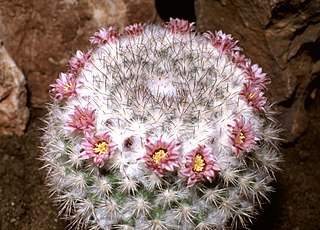
Mammillaria is one of the largest genera in the cactus family (Cactaceae), with currently 200 known species and varieties recognized. Most of the mammillaria are native to Mexico, but some come from the southwest United States, the Caribbean, Colombia, Venezuela, Guatemala and Honduras. The common name "pincushion cactus" refers to this and the closely related genus Escobaria.

Coryphantha, or beehive cactus, is a genus of small to middle-sized, globose or columnar cacti. The genus is native to arid parts of Central America, Mexico, through Arizona, New Mexico, and western Texas and north into southwestern, central, and southeastern Montana. With its two subgenera, 57 species and 20 subspecies, it is one of the largest genera of cactus.

Fishhook cactus is a common name for any hook-spined species of the genera Mammillaria, Echinomastus or Sclerocactus. They are small cacti, usually growing up to 6-7 inches (20 cm) high, and are shaped similar to a barrel cactus. They are not to be confused with the fishhook barrel cactus of the Sonoran and Chihuahuan Deserts. The Fishhook cactus is a large category of around 150 species.

Mammillaria spinosissima, also known as the spiny pincushion cactus, is a species of flowering plant in the cactus family Cactaceae, endemic to the central Mexican states of Guerrero and Morelos, where they grow at elevations of approximately 1,600 to 1,900 metres. The species was described in 1838 by James Forbes, gardener of the Duke of Bedford. Botanist David Hunt collected a specimen in 1971, when he located one near Sierra de Tepoztlan, Mexico.
Richard Ernest Kunze was a physician. He came to the United States in 1854, and was graduated at the Eclectic Medical College of New York in 1868, subsequently becoming a member of the board of trustees of this institution, was president of the New York Therapeutical Association in 1880, introduced to the medical profession various drugs derived from cacti, and added greatly to the previous knowledge of medical botany. He published a series of monographs on Cactus ; Cereus Grandiflorus and Cereus bonplandi (1876); Cereus triangularis and Phyllocactus grandis (1876); Cardinal Points in the Study of Medical Botany ; and The Germination and Vitality of Seeds (1881).
Many cacti are known to be psychoactive, containing phenethylamine alkaloids such as mescaline. However, the two main ritualistic (folkloric) genera are Echinopsis, of which the most psychoactive species is the San Pedro cactus, and Lophophora, with peyote being the most psychoactive species. Several other species pertaining to other genera are also psychoactive, though not always used with a ritualistic intent.

Mammillaria hahniana, the old lady cactus, is a species of flowering plant in the family Cactaceae, native to central Mexico. It grows to 25 cm (10 in) tall by 50 cm (20 in) broad. The solitary spherical stems, 12 cm in diameter, are covered in white down and white spines. Reddish purple flowers are borne in spring and summer, sometimes forming a complete ring around the apex of the plant.

Mammillaria nivosa is a species of cactus also known by the name woolly nipple cactus and is native to the Caribbean.

Mammillaria glassii is a species of cactus in the subfamily Cactoideae. It is a small, clumping cactus with "fluffy white spines." M. glassii is native to Mexico in the states of Coahuila and Nuevo León.

Mammillaria bocasana is a species of cactus in the subfamily Cactoideae. It is often sold as a "powder puff" cactus, and also as a "Powder Puff Pincushion." The plant is protected from collecting in the wild in Mexico.

Mammillaria fraileana is one of about 200 species of the genus Mammillaria from the cactus family Cactaceae. This species is native to Mexico and can be found along the east coast of the southern part of Baja California Peninsula in Desert Scrub communities. They tend to grow in non-calcareous dry granite-based soil but can also grow in rocky habitats, either in rock fissures or directly on top of the rock surface even without the presence of soil. Thus, the mineral composition of the rocks in their habitat directly influence their abundance. The habitat of Mammillaria fraileana is home to succulent flora and is particularly rich in local endemics. Currently, no major threats to the species are known to exist.

Mammillaria surculosa is a species of flowering plant in the cactus family Cactaceae, native to north eastern Mexico, where it occurs in extremely isolated patches at altitudes of 950–1,200 m (3,120–3,940 ft). It is registered as “Endangered” by the IUCN Red List. Growing to 10 cm (3.9 in) tall by 50 cm (20 in) wide, this tiny plant forms colonies of spiny stems with relatively large, lemon yellow flowers in spring.

Mammillaria sphaerica, the longmamma nipple cactus or pale mammillaria is a species of flowering plant in the cactus family Cactaceae, native to south eastern Texas in the USA and north eastern Mexico, where it occurs in scattered patches at altitudes up to 1,000 m (3,300 ft). It forms clumps of small pale green spheres to 5 cm (2.0 in) in diameter, with short hairs and pale yellow flowers up to 3 cm (1.2 in) wide in summer.
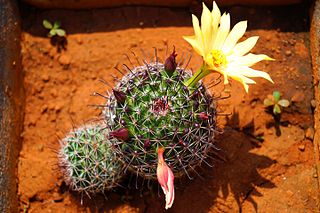
Mammillaria beneckei is a species of cacti in the tribe Cacteae. It is native to Mexico.
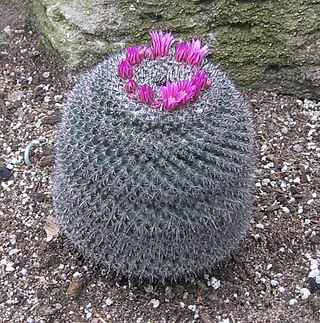
Mammillaria supertexta is a species of cacti in the tribe Cacteae. It is native to Oaxaca, Mexico.
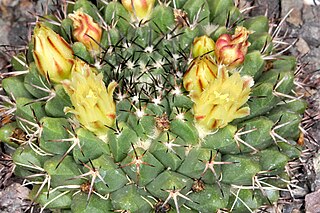
Mammillaria karwinskiana is a species of cacti in the tribe Cacteae. It is native to Mexico.

Mammillaria haageana is a species of cacti in the tribe Cacteae. It is native to Mexico, where it is found commonly, and is widespread throughout much of the country.
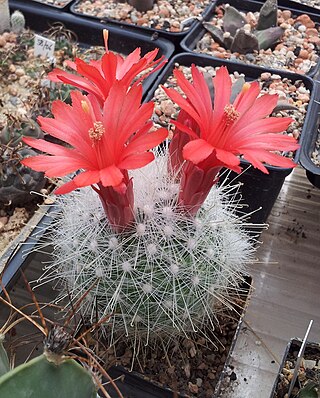
Mammillaria senilis is a species of cacti in the tribe Cacteae. It is native to Mexico, where it is found in the states of Chihuahua, Durango, Jalisco, Nayarit, Sinaloa and in south Zacatecas.



















